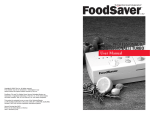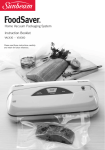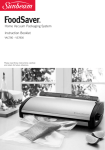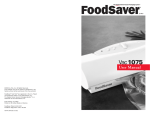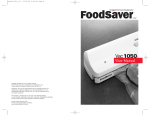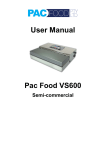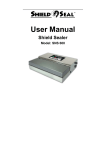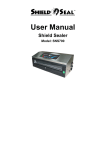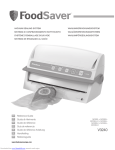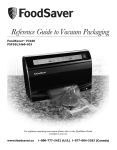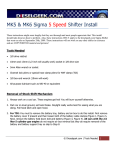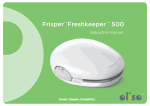Download Sunbeam VAC660 User's Manual
Transcript
® Home Vacuum Packaging System Instruction Booklet VAC660 - VS6600 Please read these instructions carefully and retain for future reference. Contents Important Safeguards 4 Important Tips 5 Features of your FoodSaver® VAC660 6 Using your FoodSaver® VAC660 8 How to Vacuum Package using FoodSaver Canisters, Bottle Stoppers & Deli Containers 10 ® Care and Cleaning Instructions 12 Vacuum Packaging Non-Food Items 13 Food Preparation and Storage Guide 14 Guidelines for Vacuum Packaging 15 Preservation Guidelines 17 Troubleshooting 19 Important instructions – retain for future use. Sunbeam’sSafeguards Important Safety Precautions Read the Instructions Carefully. For Your Own Safety, Always Follow These Basic Precautions When Using the FoodSaver® Appliance: 1. Do not use the appliance on wet or hot surfaces, or near a heat source. 2. Do not immerse any part of the appliance, supply cord or plug in water or other liquid. 3. To disconnect, unplug the supply cord from the electrical outlet. Do not disconnect by pulling on the cord. 4. Do not operate the appliance with a damaged supply cord or plug. Do not operate the appliance if it malfunctions or is in any way damaged. If the cord or the machine is damaged, it must be returned to an authorized service center. 5. Do not use an extension cord with the appliance. 6. Use only accessories or attachments recommended by Sunbeam and the FoodSaver® brand team. 7. Use the appliance only for its intended use. 8. Closely supervise children when using any electrical appliance. Do not allow the appliance to be used as a toy. 9. This appliance is not intended for use by persons (including children) with reduced physical, sensory or mental capabilities, or lack of experience and knowledge, unless they have been given supervision or instruction concerning use of the appliance by a person responsible for their safety. 10.If the supply cord is damaged, it must be replaced by the manufacturer, or its service agent or a similarly qualified person in order to avoid a hazard. 11.This appliance is intended to be used in household and similar applications such as: staff kitchen areas in shops, offices and other working environments; farm houses; by clients in hotels, motels and other residential type environments; bed and breakfast type environments. • For Household Use Only • Please Save These Instructions WARNING: To avoid dangers of suffocation, keep bag away from babies and children. This is not a toy. If you have any concerns regarding the performance and use of your appliance, please visit www.sunbeam.com.au or contact the Sunbeam Consumer Service Line. Ensure the above safety precautions are understood. 4 Important Tips When Vacuum Packaging: 1. Vacuum packaging is NOT a substitute for refrigeration. 2. Use ONLY bags, rolls and canisters manufactured by FoodSaver®. 3. Do not allow the Vacuum Channel to fill up with liquids. This will render the machine unusable. To prevent it, avoid overfilling the bags and freeze liquids first. 4. You can prevent liquids from being drawn into the appliance by placing a folded paper towel at the top of the bag, but below the seal area, before vacuum packaging. 5. Do not attempt to create your own side seals for a FoodSaver® Bag. These bags are manufactured with special side seams which are sealed all the way to the outer edge. Creating your own side seams can actually leave air channels exposed which will cause leakage and prevent a vacuum from being formed. 6. Always make sure you leave at least 2.5cm of extra bag material for each time you plan to reuse the bag. To avoid possible illness, do not reuse bags after storing meats, fish or greasy foods. 7. If you are not sure whether you have achieved a complete seal, simply seal the bag again about 1cm above the first seal. 8. Bulky items sometimes make it difficult to achieve a smooth sealing surface. Gently stretch the bag flat along the Sealing Strip before closing the lid. 9. When packaging products with sharp edges (dry spaghetti, silverware, etc.), protect the bag from punctures by wrapping the products in a cushioning material, such as paper towels, styrofoam, tissue, etc. Products can also be vacuum packaged in canisters to avoid any possibility of puncturing a bag. 10.Avoid drawing powdery or fine-grained products such as, flour, sugar and coffee grinds into the appliance. This will inhibit the vacuuming and sealing process and may clog the unit, preventing it from drawing a good vacuum. To prevent this from occurring, avoid overfilling the bags. 11.If using the Foodsaver® appliance to reseal packets, ensure that these have been previously commercially heat sealed. Do not use the sealing strip to re-seal conventional plastic wrap, sandwich bags and plastic bags as they may melt over the sealing strip. 5 VAC660 28cm vacuum packaging system with multi-fuction control panel Fast Accessory Port Mo Normal Dry Attach accessory hose here and use to vacuum package with FoodSaver® Canisters and bottle stoppers. Speed Setting Select speed to optimise the vacuum 'Normal' for average sized bags, canisters and bottle. 'Fast' for larger - sized bags and canisters. Adjustable Food Setting Select food type to optimise the seal. Dry (normal seal time) for food without liquid; Moist (longer seal time) for juicy foods. Foam Gasket Extra-wide Sealing Strip VACUU M CHAN NEL SEALIN G STR IP 6 Vacuum & Seal Button oist AUTO FUNCTION Vacuum & Seal Cancel MANUAL FUNCTION Canister Pulse Seal This button has two uses: 1. Press to vacuum package and seal with a single touch. Shuts off automatically. 2. Press to cancel process at any time. Canister Vacuum Button Press to achieve best vacuum results for canisters and bottle stoppers. Seal Button This button has three uses: 1. Press to immediately stop the vacuum process and begin sealing the bag. 2. Press to create a seal when making bags from a FoodSaver® Roll. 3.Press to create a seal on foil-based chip and cereal packets. Pulse Button Press to remove air-as much or as little as required - then press seal to complete. Vacuum channel Easy-Clean / Removable Drip Tray Easy-lock latch 7 Using your FoodSaver VAC660 ® How to make a Bag from a FoodSaver® Roll 1. Place appliance on a flat, dry surface and plug the supply cord into a standard electrical outlet. 2. Pull out enough bag material to hold item to be vacuum packaged. 3. Cut Roll to desired length, plus 7.5cm. 4. Open FoodSaver® lid. The lid may be locked. To unlock by lifting the side latch. Fast Moist AUTO FUNCTION Vacuum & Seal Normal Dry How to Vacuum Package with FoodSaver® Bags 1. Place appliance on a flat, dry surface and plug the supply cord into a standard electrical outlet. 2. Place item(s) in bag, allowing at least 7.5cm of space between bag contents and top of bag. 3. Open FoodSaver® lid and place open end of bag into the Vacuum Channel. Cancel MANUAL FUNCTION Canister Pulse Seal VACUU M CHANN EL SEALIN G STRIP Lift latch to unlock 5. Place one open end of the bag material across the sealing strip and close lid. (Do not place edge of bag into vacuum channel when sealing bags) 6. Lock lid by latching side lock. 4. Close and lock lid by locking side lock. 5. Select appropriate 'Food Setting' button. Choose 'Moist' for juicy foods or 'Dry' for foods without liquid. Appliance will default to the 'Dry' setting. 6. Select appropriate Speed setting button. Choose 'Normal' for average-sized bags and canisters or 'Fast' for larger sized bags and canisters. Appliance will default to Press Fast Normal Moist AUTO FUNCTION Vacuum & Seal Dry Cancel MANUAL FUNCTION Canister Pulse Seal VACUU M CHANN EL SEALIN G STRIP 7. Press 'Seal' button to begin automatic sealing process. 8. When seal indicator light turns off, unlock latch, lift lid and remove bag. 8 the 'Normal' speed. 7. Press 'Vacuum & Seal' Button to begin automatic vacuum and seal process. Wait 20 seconds before vacuuming and / or sealing again. Using your FoodSaver® VAC660 continued Tips on Sealing a Bag Tips on Removing Air from a Bag Make sure you've locked the appliance lid. When making a bag from a roll, place bag material on Sealing Strip, close lid and ensure latch is locked. Make sure you've locked the appliance lid. When vacuuming and sealing a bag or canister, ensure latch is locked. Prevent moisture or liquid from being pulled into the Vacuum Channel or trapped in the seal. Either pre-freeze moist food such as raw meat for 1-2 hours before vacuum packaging, or place a folded paper towel between food and end of bag to absorb excess liquids. Just be sure to leave at least 2.5cm between food and end of bag so that bag seals properly with paper towel inside. Make sure you give appliance time to cool down. Wait at least 20 seconds between seals. Under very heavy usage, appliance will not operate to prevent overheating. If it does, wait 20 minutes to allow appliance to cool off. Check for wrinkles in the bag along the Sealing Strip. Wrinkles in seal may cause leakage and allow air to come back into bag. Check for wrinkles in bag along Sealing Strip before closing lid and vacuum packaging. If you find wrinkles after sealing bag, simply cut bag open and vacuum package again. If motor runs for more than 30 seconds without stopping, consider the following: You may need to adjust bag and try again. If you are making the initial seal on a piece of bag material with two open ends, make sure bag is placed on Sealing Strip. If you are vacuum packaging with a bag, make sure open end is placed over the Vacuum Channel and make sure Accessory Hose is not attached. 9 How to Vacuum Package using FoodSaver® Canisters, Bottle Stoppers and Deli Containers 1. Place the appliance on a flat, dry surface and plug the supply cord into a standard electrical outlet. 2. Canisters: place the item(s) to be vacuum packaged inside the canister. Place the lid on top of the canister. See figure 1. Fast Normal Moist AUTO FUNCTION Vacuum & Seal Dry MANUAL FUNCTION Canister Pulse Cancel Seal Figure 1 Bottle Stoppers: insert the Bottle Stopper into the neck of the bottle. Leave at least 2.5cm between the contents and the rim. See figure 2. Fast Normal Moist Deli Containers: 1. Place the item(s) to be vacuum packaged inside the container*. Place the lid firmly on top of the container. 2. Insert one end of the Accessory Hose into the Accessory Port on your FoodSaver® appliance. 3. Insert the other end of the Accessory Hose into the hole on the top of the container adaptor. See figure 3. Twist the grey tip of hose while inserting to ensure a tight fit. AUTO FUNCTION Vacuum & Seal Dry 3. Insert one end of the Accessory Hose into the Accessory Port on the appliance. Insert the other end of the hose into the lid of canister or bottle stopper. 4. Lock the latch on the side of the appliance before vacuuming. 5. Press 'Canister' Button to begin vacuum process for either canisters or bottles, motor will run until vacuum process is complete. 6. When motor turns off, gently twist and remove Accessory Hose from appliance and canister or bottle stopper. Cancel MANUAL FUNCTION Canister Pulse Seal Figure 3 Figure 2 10 How to Vacuum Package using FoodSaver® Canisters, Bottle Stoppers and Deli Containers - Continued 4. Place the container adaptor over the grey vacuum valve on the container lid. See figure 4. How to Open the FoodSaver® Canister To open, press and hold down the grey rubber button in the centre of the lid. This will release the vacuum – a hissing sound can be heard as the air rushes in. How to Remove the FoodSaver® Bottle Stopper To remove, simply twist and pull up on the Bottle Stopper to release the vacuum. How to Open FoodSaver® Deli containers Figure 4 5. Lock the latch on the side of the appliance before vacuuming. 6. Press 'Canister' Button to begin vacuum process. Motor will run until vacuum process is complete. 7. When motor turns off, gently twist and remove Accessory Hose from appliance and container. Important: After vacuum packaging, put deli container in refrigerator or freezer. Allow hot foods to cool to room temperature before vacuum packaging. Otherwise, the contents may bubble up out the container. To open, lift the grey rubber cover in the centre of the lid. This will release the vacuum – a hissing sound can be heard as the air rushes is. *FoodSaver® Deli containers sold separately. IMPORTANT: Remember to remove the Accessory Hose from the Accessory Port on the appliance before you vacuum package in FoodSaver® Bags. DO NOT STORE CANISTER IN THE FREEZER. 11 Care and Cleaning Instructions The FoodSaver® Appliance 1. Always unplug the appliance before cleaning. 2. Clean using a mild dishwashing soap and a warm, damp cloth. Do not immerse the appliance in water. Dry thoroughly before using. 3. Do not use abrasive products or materials to clean any of the appliance components. Drip Tray Remove from appliance for easy clean. Clean drip tray in warm soapy water. FoodSaver® Bags IMPORTANT: Do not reuse bags after storing meats, fish or greasy foods. 1. Wash bags in warm water using a mild dishwashing soap. 2. Bags can be washed in the dishwasher by carefully turning the bags inside out and spreading them over the top rack of the dishwasher so that all surfaces are exposed to the washing water. 12 3. Allow bags to dry thoroughly before reusing. To avoid possible illness, do not reuse bags after storing raw meats, fish or greasy foods. Do not reuse bags that have been microwaved or simmered. FoodSaver® Accessories 1. All FoodSaver® accessories should be washed in warm water using a mild dishwashing soap. Dry thoroughly before using. 2. All FoodSaver® Canister bases (but not the lids) may be washed in the dishwasher. FoodSaver® Canister lids (white) are NOT dishwasher safe. 3. The FoodSaver® Canister base (clear) can be cleaned in the dishwasher but only in the top shelf. Items washed in bottom shelves can distort due to the heat from the dishwasher element. IMPORTANT: All plastic components deteriorate through the prolonged use of a dishwasher for cleaning. Hand washing of plastic components in warm soapy water is always recommended. Vacuum Packaging Non-Food Items Your FoodSaver® appliance also protects non-food items from oxidation, corrosion and moisture. Just follow the directions for vacuum packaging using the FoodSaver® Bags, Canisters and Accessories. • Camping and hiking gear stays dry and compact. Vacuum packaging your clothes and equipment will help save space in your bag. Vacuum package matches, maps and anything you want to stay dry. • For picnics, fill a FoodSaver® Bag with ice and seal. When it melts, you’ll have fresh water for drinking or you can put it back in the freezer as a reusable ice pack. • Vacuum package your food and equipment for a boating or sailing outing. Food will stay dry in the cooler/esky. Batteries and film won’t get damaged by water, and you’ll appreciate having a dry change of clothes. • Vacuum package first aid kits and emergency kits for your house, your boat and your car. Items will all be in one package and will stay dry and without dirt and mold. Include flares, batteries, flashlight, candles and matches. • To vacuum package silver, wrap fork prongs in soft cushioning material, such as a paper towel, to avoid puncturing bag. • For painting, vacuum package your wet paint brush between coats rather than washing out. Particularly useful for oil based paints that require mineral turpentine to clean up. 13 Food Preparation and Storage Guide Guidelines for Vacuum Packaging Food Vacuum packaging is not a substitute for canning nor can it reverse deteriorating quality; it can only slow down changes in quality. It is impossible to predict how long a specific food will have top-quality flavour, appearance and texture, because it depends on the age and condition of the food on the day it was vacuum packaged. Foods that are extremely fresh will last longer than foods that are already deteriorating. Vacuum packaging extends the life of foods by removing nearly all the air in a sealed container, thereby reducing oxidation which affects nutritional value, flavour and overall quality. However, most foods contain enough water to support micro-organisms which can grow with or without air. While microorganisms are present everywhere, only certain ones cause problems, and only under certain conditions: • Mould: Easy to identify because of its characteristic fuzz. Moulds are virtually eliminated by vacuum packaging because they cannot grow in a low oxygen environment. • Yeast: Results in fermentation, which can frequently be identified by smell or taste. Yeast requires water, sugar and a moderate temperature to grow, and can grow with or without air. Refrigeration slows the growth of yeast, and freezing stops it completely. 14 • Bacteria: Frequently results in discoloration, soft or slimy texture, and/or an unpleasant odor. 'Clostrid ium botulinum' (the organism that causes Botulism) can grow without air under the right conditions, cannot be detected by smell or taste, and although extremely rare, can be very dangerous. The combination of vacuum packaging and freezing will extend food freshness and reduce the growth of bacteria in perishable foods. Maintaining low temperatures is a critical factor in preserving foods safely. Growth of micro-organisms is significantly reduced at temperatures of 4°C or below. Freezing at -17°C does not kill micro-organisms, but it stops them from growing. For long term storage, always freeze “perishable” foods that have been vacuum packaged. Thawing and Heating Vacuum Packaged Foods Always thaw foods in either the Refrigerator or microwave – do not leave “perishable” foods at room temperature to thaw. To microwave in a FoodSaver ® Bag, cut a corner of the bag and place on a microwavesafe dish. You can always reheat foods in FoodSaver® Bags by placing them in water at a low simmer below 75°C. NOTE: Vacuum packaging is NOT a substitute for refrigeration or freezing. Any “perishable” foods that require refrigeration prior to vacuum packaging still must be refrigerated or frozen after vacuum packaging. Guidelines for Vacuum Packaging Preparation Guidelines for Meat and Fish For best results, pre-freeze meat and fish for 1-2 hours before vacuum packaging in a FoodSaver® Bag. This helps retain the juice and shape and guarantees a better seal. If it's not possible to pre-freeze, place a folded paper towel between meat or fish and top of bag but below seal area. Leave paper towel in bag to absorb excess moisture and juices during vacuum packaging process. Note: Beef may appear darker after vacuum packaging due to the removal of oxygen. This is not an indication of spoilage. Preparation Guidelines for Hard Cheeses To keep cheese fresh, vacuum package it after each use. Make your FoodSaver® Bag extra long, allowing 2.5cm of bag material for each time you plan to open and reseal in addition to the 7.5cm room you normally leave between contents and seal. Simply cut sealed edge and remove cheese. When you're ready to repackage the cheese, just drop it in bag and reseal. Preparation Guidelines for Vegetables Vegetables need to be blanched before vacuum packaging. This process stops the enzyme action that could lead to loss of flavour, colour and texture. To blanch vegetables, place them in boiling water for 1 to 2 minutes. After blanching, immerse vegetables in iced cold water to stop the cooking process. Finally, dry vegetables on a towel before vacuum packaging. When freezing vegetables, it is best to pre-freeze them for 1-2 hours or until solidly frozen. To freeze vegetables in individual servings, first place on a baking sheet and spread them out so they are not touching. This prevents them from freezing together in a block. Once they are frozen, remove from baking sheet and vacuum package vegetables in a FoodSaver ® Bag. After they have been vacuum packaged, return them to the freezer. Note: Cruciferous vegetables (broccoli, Brussels sprouts, cabbage, cauliflower, kale, turnips) naturally emit gases during storage. Therefore, after blanching, they must be stored in freezer only. Important: Mushrooms and garlic should never be vacuum packaged. Preparation Guidelines for Leafy Vegetables For best results, use a canister to store leafy vegetables. First wash the vegetables and then dry with a towel or salad spinner. After they are dried, put them in a canister and vacuum package. Store in refrigerator. Preparation Guidelines for Fruits When freezing soft fruits or berries, it is best to pre-freeze them for 1-2 hours or until solidly frozen. To freeze fruit in individual servings, first place on a baking sheet and spread them out so they are not touching. This prevents them from freezing together in a block. Once they are frozen, remove from baking sheet and vacuum package fruit in a FoodSaver ® Bag. After they have been vacuum packaged, return them to the freezer. You can vacuum package portions for baking, or in your favourite combinations for easy fruit salad all year round. If storing in the refrigerator, we recommend using a FoodSaver® Canister. 15 Guidelines for Vacuum Packaging continued Preparation Guidelines for Baked Goods Preparation Guidelines for Marinating To vacuum package soft or airy baked goods, we recommend using a FoodSaver® Canister so they will hold their shape. If using a bag, pre-freeze for 1-2 hours or until solidly frozen. To save time, make cookie dough, pie shells, whole pies, or mix dry ingredients in advance and vacuum package for later use. Vacuum sealing opens the pores in foods such as meats, poultry and seafood absorbing marinades much faster than traditional marinating methods. Marinating can occur in either FoodSaver® Bags or Canisters. Preparation Guidelines for Coffee and Powdery foods To prevent food particles from being drawn into vacuum pump, place a coffee filter or paper towel at top of bag or canister before vacuum packaging. You can also place the food in its original bag inside a FoodSaver® Bag. Preparation Guidelines for Liquids Before you vacuum package liquids such as soup stock, pre-freeze in a casserole dish, loaf pan or ice cube tray until solid. Remove frozen liquid from pan and vacuum package in a FoodSaver® Bag. You can stack these "frozen bricks" in your freezer. When you're ready to use, just cut corner of bag and place in a dish in microwave or drop into water at a low simmer below 75˚C. To vacuum package non-carbonated bottled liquids, you can use a FoodSaver® Bottle Stopper with the original container. Remember to leave at least 2.5cm of room between contents and bottom of Bottle Stopper. You can re-seal bottles after each use. Preparation Guidelines for Snack Foods Your snack foods will maintain their freshness longer when you vacuum package them. For best results, use a FoodSaver® Canister for crushable items like crackers. 16 Do not overfill bags with marinating liquid. This ensures that liquid does not enter the vacuum channel. Note: Marinating times will vary depending on the type of marinade being used. Do not marinate for more than 5-10 minutes if the marinade contains acidic ingredients, such as lemon juice and vinegar. Re-sealing Chip packets, etc Whilst we recommend only using FoodSaver® Bags and Rolls to vacuum package items, you can also utilise the sealing strip to re-seal pockets that have already undergone a commercial quality seal. The heat sealing strip allows half consumed packets of chips, crackers and cereals to be resealed by placing on heating sealing strip. Ensure that the bag does not reach into the vacuum channel, as it will crush delicate items. Only re-seal packets. NOTE: Do not use the sealing strip to seal conventional plastic wrap, sandwich bags and plastic bags as the bags may melt over the sealing strip. Preservation Guidelines Foods Where to Store Recommended FoodSaver® Storage Storage Life with FoodSaver® Normal Storage Life Meat Beef, Pork, Lamb Freezer FoodSaver® Bag 2-3 years 6 months Ground Meat Freezer FoodSaver Bag 1 year 4 months Poultry Freezer FoodSaver Bag 2-3 years 6 months Fish Freezer FoodSaver® Bag 2 years 6 months ® ® Hard Cheeses Cheddar, Swiss Refrigerator FoodSaver® Bag, Canister 4-8 months 1-2 weeks Parmesan Refrigerator FoodSaver Bag, Canister 4-8 months 1-2 weeks ® Vegetables (Vegetables, excluding leafy types, must be blanched before vacuum sealing.) Asparagus Freezer FoodSaver® Bag 2-3 years 8 months Broccoli, Cauliflower Freezer FoodSaver Bag 2-3 years 8 months Cabbage, Brussels Sprouts Freezer FoodSaver Bag 2-3 years 8 months Corn (cob or kernel) Freezer FoodSaver® Bag 2-3 years 8 months Green Beans Freezer FoodSaver Bag 2-3 years 8 months Lettuce, Spinach Refrigerator FoodSaver Canister 2 weeks 3-6 days Snow Peas, Snap Peas Freezer FoodSaver Bag 2-3 years 8 months Apricots, Plums Freezer FoodSaver® Bag 1-3 years 6-12 months Peaches, Nectarines Freezer FoodSaver® Bag 1-3 years 6-12 months ® ® ® ® ® Fruits Softer Berries Raspberries, Blackberries Refrigerator FoodSaver® Canister 1 week 1-3 days Strawberries Refrigerator FoodSaver® Canister 1 week 1-3 days Blueberries Refrigerator FoodSaver® Canister 2 weeks 3-6 days Cranberries Refrigerator FoodSaver® Canister 2 weeks 3-6 days Harder Berries 17 Preservation Guidelines continued Foods Where to Store Recommended FoodSaver® Container Storage Life with FoodSaver® Normal Storage Life Baked Goods Freezer FoodSaver® Bag 1-3 years 6-12 months Almonds, Peanuts Pantry FoodSaver® Bag, Canister 2 years 6 months Sunflower Seeds Pantry FoodSaver Bag, Canister 2 years 6 months Coffee Beans Freezer FoodSaver® Bag 2-3 years 6 months Coffee Beans Pantry FoodSaver Bag, Canister 1 year 3 months Ground Coffee Freezer FoodSaver Bag 2 years 6 months Ground Coffee Pantry FoodSaver® Bag, Canister 5-6 months Freezer FoodSaver® Bag 1-2 years Bagels, Bread, Pastries Nuts ® Coffee ® ® Prepared Liquids Sauces, Soups, Stews 3-6 months Bottled Liquids Wine Refrigerator FoodSaver® Bottle Stopper 2-4 months Oils Pantry FoodSaver Bottle Stopper 1-1½ years 5-6 months Beans, Grains Pantry FoodSaver® Bag, Canister 1-2 years 6 months Pasta, Rice Pantry FoodSaver Bag, Canister 1-2 years 6 months Dry Milk Pantry FoodSaver® Bag, Canister 1-2 years 6 months Dried Coconut Pantry FoodSaver® Bag, Canister 1-2 years 6 months Flour Pantry FoodSaver Bag, Canister 1-2 years 6 months Sugar, Brown Sugar Pantry FoodSaver Bag, Canister 1-2 years 6 months Chips Pantry FoodSaver® Canister 3-6 weeks 1-2 weeks Cookies, Crackers Pantry FoodSaver Canister 3-6 weeks 1-2 weeks ® 1-3 weeks Dry Foods ® Powdery Foods ® ® Snack Foods 18 ® Troubleshooting Nothing happens when the on button is pressed: • Check to see that the appliance is plugged in. Test electrical outlet by plugging in another appliance. • The appliance will shut off automatically if overheated. Allow to cool down for 20 minutes and try again. • Check supply cord and plug for damage. If damaged, do not use the appliance. Air is not removed from the bag: • To seal properly, open end of bag should be resting entirely inside Vacuum Channel area. • Check sealing strip and gasket beneath the lid for debris. Wipe off and then smooth back into place. • Bag may have a leak. To test, seal the bag with some air in it, submerge in water, and apply pressure. Bubbles indicate a leak. Reseal or use another bag. • Open bag and dry/wipe at top end of bag. Ensure no food particles are in/around top of bag. Air was removed from the bag, but has come back into the bag: • Leaks along the seal can be caused by wrinkles, crumbs, grease or liquids. Reopen bag, wipe the top inside of the bag and smooth it out along the sealing strip before resealing. • The release of natural gases or fermentation from foods, (such as fresh fruits and vegetables) may have occurred. Most vegetables require blanching prior to vacuum packing. See page 14 for more details. Open bag, if you think food has begun to spoil, discard food. Lack of refrigeration or fluctuating temperatures in the Refrigerator can cause food to spoil. • Check the bag for a puncture or hole, which may have released the vacuum. Cushion sharp edges in the contents of the bag with paper towels. The Bag Melts: • Should sealing strip overheat and melt the bag, it may be necessary to lift the lid and allow sealing strip to cool for a few minutes. • Built-in safety shut-off may shut the appliance off if it becomes overheated. Allow the unit to cool down for 20 minutes and try again. The FoodSaver ® Storage Life with FoodSaver® Canister will not vacuum: • Make sure the rubber gasket on the canister lid is free from food materials, crumbs, coffee grinds, etc. • Make sure the rim of the canister does not have any cracks or scratches. Any gaps can prevent a vacuum from forming. • Make sure you aren’t filling the canister too full prior to vacuum packaging. Always leave at least 2.5cm between the contents and the lid. The FoodSaver® Storage Life with FoodSaver® Bottle Stopper will not vacuum: • Make sure the Bottle Stopper is fitting snugly inside the bottle. If it is loose, air may leak in and prevent a vacuum from forming. • Make sure the neck of the bottle and tip of the Accessory Hose are free from food materials, crumbs, etc. Any gaps will prevent a vacuum from forming: Note: For all accessories, make sure the Accessory Hose is completely inserted into appliance and lid of accessory. Twist grey tab on Accessory Hose while inserting to ensure a tight fit. 19 Notes Notes Notes 12 Month Replacement Guarantee In the unlikely event that this appliance develops any malfunction within 12 months of purchase (3 months commercial use) due to faulty materials or manufacture, we will replace it for you free of charge. Should you experience any difficulties with your appliance, please phone our customer service line for advice on 1300 881 861 in Australia, or 0800 786 232 in New Zealand. Alternatively, you can send a written claim to Sunbeam at the address listed below. On receipt of your claim, Sunbeam will seek to resolve your difficulties or, if the appliance is defective, advise you on how to obtain a replacement or refund. Your Sunbeam 12 Month Replacement Guarantee naturally does not cover misuse or negligent handling and normal wear and tear. Similarly your 12 Month Replacement Guarantee does not cover freight or any other costs incurred in making a claim. Please retain your receipt as proof of purchase. The benefits given to you by this guarantee are in addition to your other rights and remedies under any laws which relate to the appliance. Our goods come with guarantees that cannot be excluded under the Australian Consumer Law and under the New Zealand Consumer Guarantees Act. In Australia you are entitled to a replacement or refund for a major failure and for compensation for any other reasonably foreseeable loss or damage. You are also entitled to have the goods repaired or replaced if the goods fail to be of acceptable quality and the failure does not amount to a major failure. Should your appliance require repair or service after the guarantee period, contact your nearest Sunbeam service centre. For a complete list of Sunbeam’s authorised service centres visit our website or call: Australia www.sunbeam.com.au 1300 881 861 Units 5 & 6, 13 Lord Street Botany NSW 2019 Australia New Zealand www.sunbeam.co.nz 0800 786 232 26 Vestey Drive, Mt Wellington Auckland, New Zealand Need help with your appliance? Contact our customer service team or visit our website for information and tips on getting the most from your appliance. In Australia Visit www.sunbeam.com.au Or call 1300 881 861 In New Zealand Visit www.sunbeam.co.nz Or call 0800 786 232 Distributed by: Sunbeam Corporation Limited ABN 45 000 006 771 Sunbeam Corporation is a division of GUD Holdings Ltd. is a registered trademark. www.sunbeam.com.au Units 5 & 6, 13 Lord St Botany NSW 2019 Australia Unit 3, Building D, 26 Vestey Drive Mt Wellington, Auckland New Zealand © 2011 Sunbeam Products Inc. doing business as Jarden Consumer Solutions. All rights reserved. Foodsaver® is a registered trademark of Sunbeam Products, Inc. Some images and text are copywrited. Made in China. Due to minor changes in design or otherwise, the product may differ from the one shown in this leaflet. 9/11
























